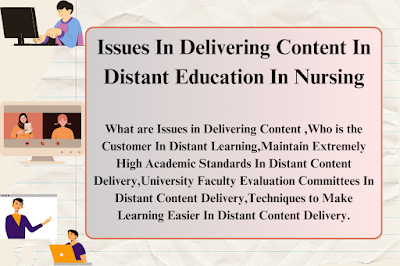What are Issues In Delivering Content In Distant Education In Nursing. Delivering Content In Distant Education In Nursing Distance education in nursing presents unique opportunities and challenges.
The Issues In Delivering Content In Distant Education In Nursing
Understanding and addressing these challenges is key to delivering high-quality, effective learning experiences. This overview will explore the key issues in delivering content, the role of the customer in distance learning, maintaining academic standards, faculty evaluations, and techniques to enhance learning in a virtual environment.
Issues in Delivering Content
Key Issues in Distance Content Delivery
Delivering content effectively through distance education involves navigating several challenges:
- Knowing Your Customer: Understanding the needs and expectations of your students is crucial. This involves not only recognizing their educational needs but also their preferences for how they receive and interact with content.
- Development of a Student Facilitation Model: Creating a model that supports students in navigating the online learning environment is essential. This includes providing guidance on how to engage with the material and access support when needed.
- Preservation of Academic Standards: Ensuring that the content delivered maintains high academic standards is critical. This includes avoiding grade inflation and ensuring that the content is rigorous and relevant.
- Registration and Enrollment Issues: Streamlining the registration and enrollment process to avoid delays and frustrations for students is important. This involves having a user-friendly online system for registration, payments, and transcript requests.
Each of these areas requires careful consideration to offer a credible and high-quality educational program.
Who is the Customer in Distance Learning?
In distance education, students are the primary customers. Here’s why:
- Student-Centric Approach: With more institutions offering online courses, students have many options. Thus, excellent service and user experience are crucial in attracting and retaining students.
- Marketing and Service: Effective marketing through various channels, including trade journals, search engines, and professional networks, is essential. Additionally, providing online registration, enrollment, and transcript services enhances convenience and satisfaction.
- Future Employers: Beyond current students, future employers of graduates are also critical customers. Maintaining strong relationships with industry professionals ensures that the curriculum remains relevant and meets industry needs.
- Society at Large: Ultimately, the value of an educational program is judged by societal respect for its graduates. Maintaining a good reputation involves ensuring that graduates possess the skills and knowledge to succeed in their careers.
Maintaining Extremely High Academic Standards in Distance Content Delivery
Ensuring Academic Rigor
Maintaining high academic standards is fundamental to the credibility of a distance education program:
- Quality of Content: Courses should offer substantial and applicable knowledge and skills. For instance, if graduates lack fundamental skills, the value of their degrees diminishes.
- Peer Review: Implementing a peer review process ensures that course content is rigorously evaluated. Expert instructors should review and approve courses before they go live to ensure quality and consistency.
- Avoiding Grade Inflation: Faculty evaluations should be fair and not solely based on student satisfaction. A link between student evaluations and grades should be carefully managed to avoid grade inflation.
- Addressing Complaints: Administrators should distinguish between valid complaints and those based on unrealistic expectations. High standards must be upheld despite student pressures.
University Faculty Evaluation Committees in Distance Content Delivery
Evaluating Faculty Effectively
Faculty evaluation committees play a crucial role in assessing the quality of teaching and course delivery:
- Student Evaluations: While student evaluations provide valuable feedback, they should be considered alongside other indicators of course quality. Evaluations linked to grades should be handled cautiously to prevent grade inflation.
- Comprehensive Review: Evaluations should include peer reviews, curriculum assessments, and feedback from industry professionals. This comprehensive approach ensures a more accurate assessment of faculty performance and course quality.
- Balance and Fairness: Faculty evaluations should balance student feedback with objective measures of teaching effectiveness. This includes assessing course rigor, engagement strategies, and learning outcomes.
Techniques to Make Learning Easier in Distance Content Delivery
Enhancing Learning Experience
To facilitate effective learning in distance education, consider the following techniques:
- Organize Material Logically: Structure content in a clear and sequential manner. Avoid unnecessary complexity and ensure that each module builds upon the previous one.
- Set Clear Objectives: Define specific, measurable, and achievable learning objectives for each module. For example, instead of vague objectives, specify what students should be able to demonstrate or list.
- Incorporate Visuals: Utilize photos, graphics, and videos to make content engaging and easier to understand. Visual aids can help break down complex information and maintain student interest.
- Break Content into Manageable Units: Divide challenging content into smaller, more digestible segments. Use interactive activities and exercises to reinforce learning and provide practical applications.
- Piecemeal Approach: Teach difficult concepts in stages. For instance, in nursing education, teach assessment techniques before diving into complex diagnoses and interventions. This approach helps students build a solid foundation.
- Enforce Deadlines: Maintain discipline by setting clear deadlines and enforcing them. Allow flexibility only for genuine emergencies. This helps students stay on track and manage their time effectively.
Conclusion
Distance education in nursing presents both opportunities and challenges. By addressing issues related to content delivery, understanding the role of students as customers, maintaining high academic standards, and implementing effective teaching techniques, institutions can enhance the quality of their online programs. Focusing on these areas ensures that distance education remains a viable and effective mode of learning, preparing students for successful careers in nursing.
Read More:
https://nurseseducator.com/didactic-and-dialectic-teaching-rationale-for-team-based-learning/
https://nurseseducator.com/high-fidelity-simulation-use-in-nursing-education/
First NCLEX Exam Center In Pakistan From Lahore (Mall of Lahore) to the Global Nursing
Categories of Journals: W, X, Y and Z Category Journal In Nursing Education
AI in Healthcare Content Creation: A Double-Edged Sword and Scary
Social Links:
https://www.facebook.com/nurseseducator/
https://www.instagram.com/nurseseducator/
